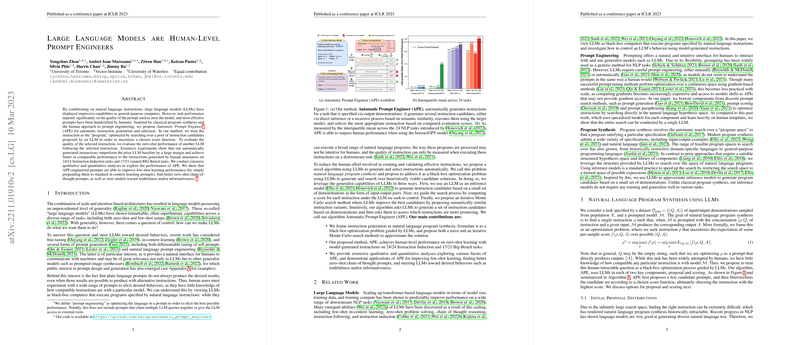LLMs are Human-Level Prompt Engineers: An Overview
This essay provides a detailed overview of the research presented in "LLMs are Human-Level Prompt Engineers" by Zhou et al. The paper introduces a novel method called Automatic Prompt Engineer (APE), which leverages LLMs to automate the generation and selection of prompts to maximize their performance across various natural language tasks.
Methodology
The authors frame prompt engineering as a natural language program synthesis problem, structured as a black-box optimization task. This approach involves two primary components: proposal generation and scoring.
- Proposal Generation: The LLMs are used to generate candidate instructions based on input-output pairs. Two modes of generation are employed:
- Forward Mode Generation: Instructions are directly inferred from input-output demonstrations.
- Reverse Mode Generation: An LLM with infilling capabilities suggests instructions to complete the task when provided with partial input.
- Scoring Function: Various scoring functions are employed to evaluate the quality of the generated instructions. These functions measure how well a generated prompt aligns with the desired task performance using metrics such as execution accuracy and log probability of outputs.
The APE process iteratively refines the prompts using Monte Carlo search methods by generating new candidate instructions based on the highest-scoring candidates from previous rounds.
Results
The research rigorously evaluates APE across several benchmarks, including the Instruction Induction benchmark and curated BIG-Bench tasks. Key findings from the evaluations are:
- Instruction Induction Benchmark: APE-generated instructions outperform default LLM baselines and achieve performance on par or better than human-generated instructions across 24 tasks. Notably, APE reached human-level performance on all tasks.
- BIG-Bench Tasks: APE demonstrated superior performance on 17 out of 21 tasks when compared to default human-generated prompts.
- TruthfulQA: APE showed significant improvements in generating prompts that guided LLMs towards higher truthfulness and informativeness in responses.
- Zero-shot Chain-of-Thought: APE optimizes chain-of-thought prompts, enhancing LLM performance on complex reasoning tasks like arithmetic and word problems.
Implications
The implications of this research are both practical and theoretical:
- Practical Implications: APE reduces the human effort required in crafting effective prompts, making LLMs more accessible and efficient. This automation is particularly beneficial given the scalability and generality of LLMs in diverse applications. Improved prompt efficiency directly translates to lower computational costs in deploying LLMs for various tasks.
- Theoretical Implications: The paper positions LLMs as capable entities for program synthesis, extending their utility beyond mere text generation to intelligent and context-aware prompt creation. This paradigm shift promotes viewing LLMs through the lens of program execution, potentially influencing future research directions in AI.
Future Directions
The research opens several avenues for future exploration:
- Enhanced Scoring Functions: Fine-tuning and developing more sophisticated scoring metrics could yield even better alignment between generated prompts and task requirements.
- Transferability of Prompts: Exploring the potential for prompts generated by APE to generalize across different LLMs can further the understanding of compatibility and efficiency.
- Integration with In-Context Learning: Combining APE with few-shot in-context learning promises to boost performance by optimizing the interplay between instructions and contextual examples.
Conclusion
The research presented by Zhou et al. marks a significant advancement in the automation of prompt engineering using LLMs. APE demonstrates the potential to surpass human-led prompt generation, significantly enhancing the usability and efficiency of LLMs. The implications of this work extend beyond current capabilities, suggesting a future where AI models can autonomously adapt and optimize their behaviors through intelligent prompt engineering.
